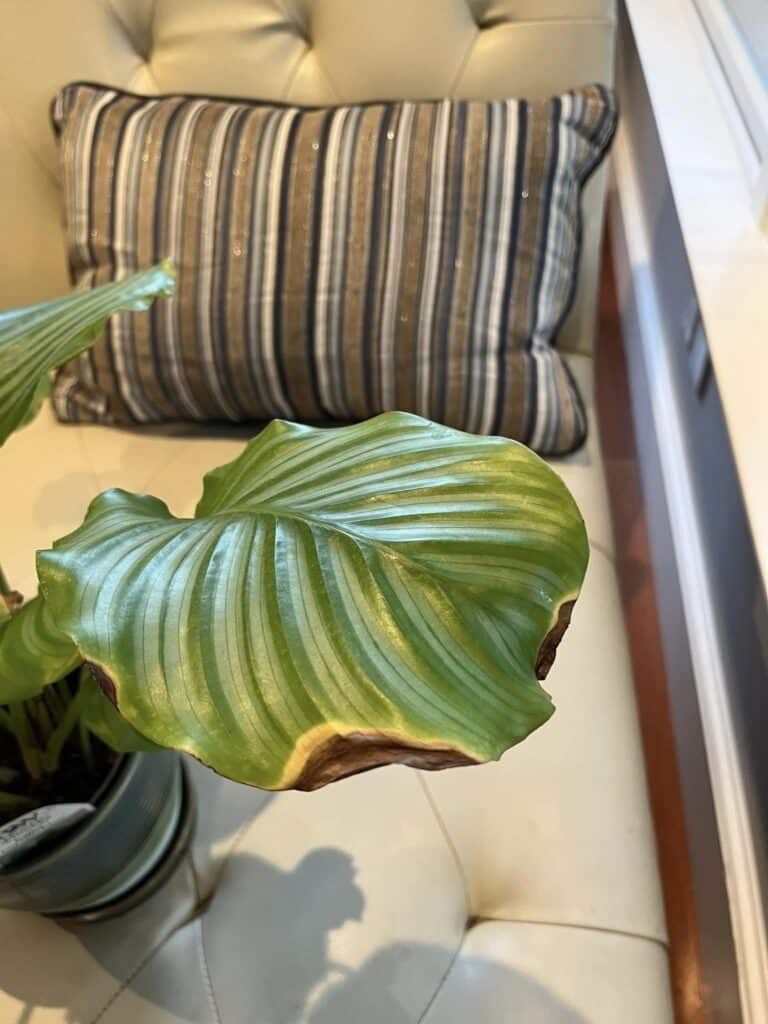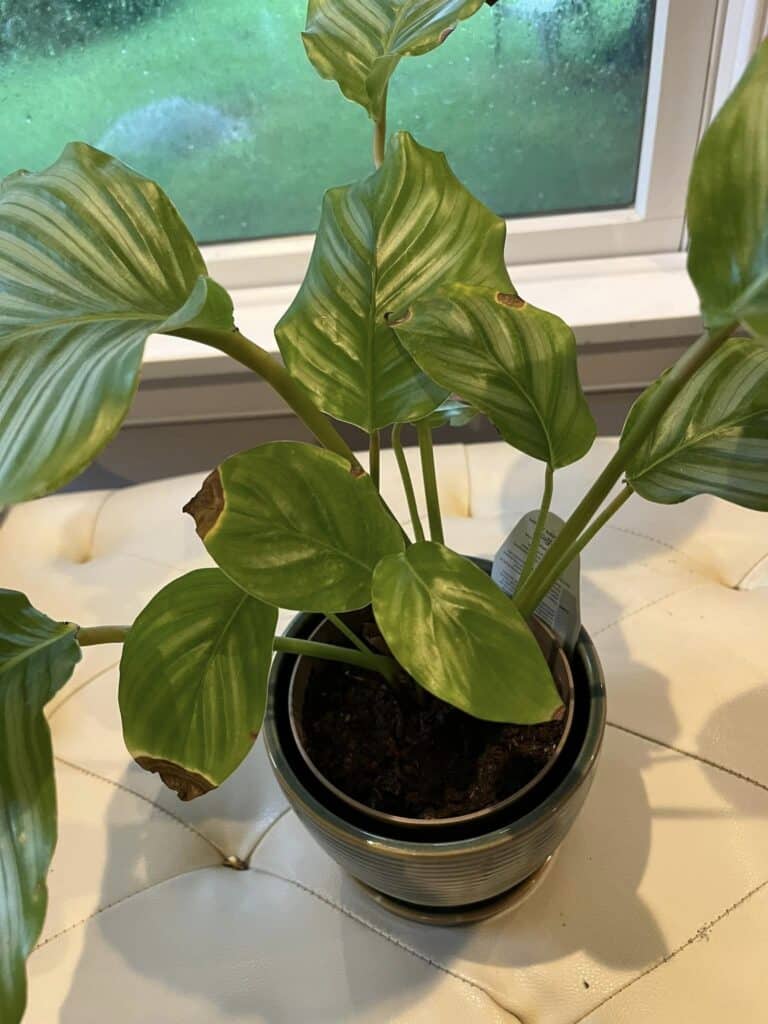The sight of brown-tipped leaves can be both perplexing and disheartening, leaving you pondering the cause behind these unsightly blemishes on your cherished green companions. Beyond the aesthetic concerns, these brown tips might signify underlying issues that demand attention.
So, why are your houseplants getting brown tips on their leaves, and how do you fix the problem? Brown tips on houseplants can happen for many reasons, from moisture imbalances and nutrient deficiencies to improper watering techniques and even stress.
Why Do House Plants Get Brown Tips On Their Leaves?
To address the issue and stop further damage, you will want to know the exact cause of brown-tipped leaves on your houseplants.
Here are the common reasons.
1. Overwatering
Overwatering your houseplants is a major cause of leaves with brown tips. Too much water makes the soil waterlogged. If you let your houseplants sit in waterlogged soil, the lack of oxygen will suffocate the roots.
This impairs the roots’ ability to take up water and nutrients, eventually leading to various symptoms, including brown tips on the leaves.
Too much water will also make the leaves of your houseplants appear soft, limp, and mushy.
2. Underwatering
You may have also deprived your houseplants of water, so if you see the leaves turning brown, ask yourself, are my houseplants getting enough water? Unlike overwatered houseplants, the leaves of underwatered houseplants dry out, curl, and become crinkly.
3. Lack of Humidity
Owing to their native homes, the tropical regions where humidity levels are higher, many houseplants prefer humid environments. Therefore, the leaves can turn brown when the air gets too dry. This often happens in summer and winter when you mostly use artificial heating or air conditioning.
4. Fertilizer Issues
Your houseplants require fertilizers to grow and thrive, but instead of aiding their growth, you could hurt your plants if you misapply fertilizer or use too much. Overfertilization leads to salt buildup in the soil, affecting the plant’s water and nutrient absorption ability, resulting in brown tips.
5. Improper Lighting
Insufficient or excessive light can stress a plant and cause its leaves to develop brown tips. For instance, exposing your houseplants to too much sunlight can burn the edges and tips of the leaves of your houseplants, causing burnt and brown spots. Eventually, the foliage will get scorched.
6. Temperature Stress
A lot of houseplants don’t particularly do well in cold temperatures. Therefore, drastic temperature fluctuations, especially exposure to cold drafts or sudden changes, can cause the leaves to develop brown tips. Air conditioning, doors, or windows cause cold drafts that can shock plants and lead to brown tips.
7. Chemical Exposure
Brown tips on your houseplant’s leaves can also be due to chemical exposure, but how did my plants get exposed to chemicals, you ask? Tap water contains minerals like chlorine, calcium, and fluoride, and they affect the growth of plants.
These minerals can accumulate in the soil over time and cover the roots of your houseplants, keeping your plants from absorbing water and nutrients, leading to white spots and brown tips.
8. Pests and Diseases
Some pests like spider mites and diseases like fungal infections can damage the leaves, causing them to turn brown, wilt, and die. So, if you notice the tips of your houseplants’ leaves turning brown, check for pests and diseases.
Related Posts:
- Pothos Leaves Turning Yellow And Brown
- How To Get Rid Of Spider Mites On Plants
- Plants That Don’t Need Much Sunlight
- How to get rid of fungus gnats in houseplants naturally
How Do You Fix Brown Tips On Houseplants?
After getting to the bottom of the cause of brown-tipped leaves on your houseplants, the next step is to take the appropriate steps to fix the problem.
a) Adjust Watering
Adjust your watering routine to prevent over or under-watering your houseplants. Remember, plants differ in their watering needs. So, consider your houseplants’ needs when developing a watering schedule.
Some plants do well when you let the soil dry before watering again, while others prefer persistently moist soil.
Stick a finger inside the soil, approximately an inch deep, before watering to be sure it is time to water. Only Water houseplants with dry soil; hold off if it’s still moist.
When you do water, ensure the water reaches the entire root ball and water until the surplus comes out of the draining hole. Also, don’t let your plants sit in standing water for extended periods.
b) Increase Humidity
You can briefly solve this problem by misting your houseplants in the morning. However, a humidifier provides an excellent solution against low humidity as it helps maintain consistent humidity levels in the air. So, place a humidifier near your plants, especially in dry indoor environments.
Also, create a microclimate with higher humidity by grouping your houseplants. This way, as your plants transpire, the moisture is released, making the surrounding air more humid.
You can also put a pebble or decorative stoned-filled shallow tray beneath your plants. Then, add water to the tray, but keep the water level just below the surface of the stones so that the humidity around the plants increases as the water evaporates.
Another option is to move your houseplants to naturally humid places; these include kitchens and bathrooms. It is also best to keep plants away from direct heat sources like radiators or heaters because they can further dry the air.
Related Post: Why Does My Spider Plant Have Brown Tips?
c) Provide Proper Lighting
Since some plants thrive in bright, indirect light, while others can tolerate lower light levels, research your houseplant species’ light requirements. Position your houseplants where they receive the appropriate type of light once you know the best lighting for them.
Also, observe the amount of sun your plant receives throughout the day. This is because if the light is too intense, it could cause sunburn and brown tips, and if it’s too dim, the plant might not get enough light for photosynthesis.
Furthermore, LED or fluorescent grow lights come in handy if natural light is limited.
d) Check Fertilizing
Review your fertilizing habits if the issue is improper fertilizing. Dilute the fertilizer and follow the appropriate application rates to avoid overfertilization. In addition, periodically flush the soil with plain water to leach out accumulated salts from previous fertilizations.
Also, don’t let the fertilizer get on the leaves because it can cause leaf burn, leading to brown tips.
d) Address Temperature Stress
Do your houseplants prefer warmer conditions or thrive in cooler environments? Find out this information so that you can provide your plants with proper growing temperatures and avoid extreme temperature fluctuations.
Keep your plants in an environment with stable temperatures and within the plant species’ optimal range. In addition, protect your plants from cold drafts from doors, windows, air conditioning units, and heating vents.
Prevent stagnant air pockets that might become too cold or too hot for your plants by ensuring there’s proper air circulation inside your house.
e) Prevent Chemical Exposure
Instead of watering your houseplants with tap water, use filtered water to reduce the chemical content in the soil. Additionally, consider Collecting rainwater for your plants, as it’s naturally free of the chemicals found in tap water.
If you decide to use tap water, let it sit out for a day or two before using it on your plants to let some chemicals dissipate. Alternatively, neutralize chlorine and other chemicals in tap water using dechlorination products.
f) Control Pests and Diseases
Regularly check your houseplants for pest signs, such as insects, webs, or sticky residue, as well as disease symptoms like wilting, spots, or discoloration. This will ensure you catch and fix any problems early.
Isolate infected plants to prevent the issue from spreading, and quarantine new houseplants for some weeks before mixing them with your other houseplants.
In addition, trim away and dispose of heavily infested or diseased parts of the plant to prevent further spread. Address fungal diseases with an appropriate fungicide.
Also, control pests with insecticidal soap, neem oil, and natural predators like ladybugs, predatory mites, or parasitic wasps.
g) Trim Damaged Leaves
Examine the leaves of your houseplants and trim the affected parts if only the tips are brown. However, if the damage extends to the whole leaf, you will have to remove the entire leaf.
Trim the leaf at a slight angle and cut just above a leaf node or stem joint to promote a more natural appearance and prevent water from collecting on the cut edge.
When trimming the leaves, use smooth and decisive cuts to avoid tearing the leaf tissue and stressing the leaves. Also, remove the affected parts and leave the healthy parts.
Collect the trimmed leaves and dispose of them in the compost or trash because they may harbor pests and diseases. Also, after cutting, sterilize your pruning tools with a disinfectant or rubbing alcohol to curb potential pathogens’ spread.
Trimming damaged leaves improves the appearance of your plant. In addition, it encourages new growth and redirects the plant’s energy toward healthier parts.
Conclusion
Now that you know why the leaves of your houseplants have brown tips, you can fix this problem and foster a healthier and more vibrant indoor plant collection. By fixing and caring for your houseplants properly, you will once again enjoy the beautiful foliage of your houseplants.

Hey there, fellow plant enthusiasts! I’m Rachel, the green-thumbed writer behind Rooted In Garden. With a deep-rooted love for all things botanical, I’ve made it my mission to help you cultivate a thriving collection of houseplants. As a devoted plant parent myself, I understand the joys and challenges that come with nurturing these leafy wonders. Whether you’re a succulent aficionado, an orchid enthusiast, or simply adore all potted flora, join me on this journey as we explore the secrets to growing and caring for our beloved green companions. Together, let’s create a flourishing oasis indoors.


